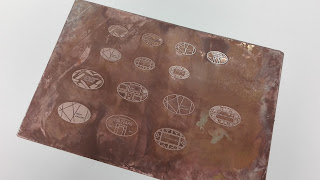Production of Pennies
To create the pennies copper would be etched with the penny designs using an acid bath then cut out
Pressed pennies usually are made by squashing a penny through two metal rollers. One has the design on so the penny gets pushed into this creating the design on the penny. Creating metal stamps is expensive so an alternative method of creating the design was needed. Copper etching was a process suggested by technicians as possibly creating a raised design on copper so that it would have a similar aesthetic to a pressed penny.
The technique would involve screen printing the designs onto a copper plate using a special chemical. The copper plate was buffed and cleaned by a technician before the designs were screen printed onto the copper. The chemical fixed to the copper plate so that when the copper was placed within the acid bath any copper left exposed was etched away. To use this technique negatives were needed of the designs. Black areas within the designs would cover the copper and therefore be raised after the acid process.
The designs had to be adapted, as the first print of the chemical by the technician onto the copper didn't come out completely, with some of the text and lines not printing at all. It was suggested that because the chemical is a different consistency to normal screen printing ink it was more difficult to print with. Also potentially the screen needed to be cleaner and making the text and some of the lines thicker would allow more space for the chemical to be applied to the copper.
The copper was left in the acid bath for a few hours to etch away at the design. After about four hours in the acid bath the design was removed from the acid bath and wiped down revealing the etching. The design was rubbed down with white spirit to remove the ink from the copper, which then exposed the shiny surface of the copper design underneath.
After this the designs were cut out into long strips on the metal bandsaw and divided into rectangles. Some of the excess was cut off using a small hacksaw. The remaining excess was sanded down on the metal belt sander. This allowed the pennies to be shaped more easily into the curved shapes. Wire wool was used to buff the designs after to create a shiny finish.












No comments:
Post a Comment
Note: only a member of this blog may post a comment.